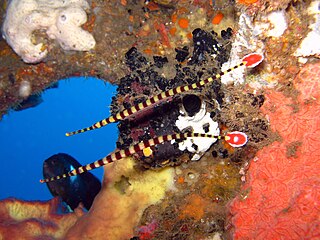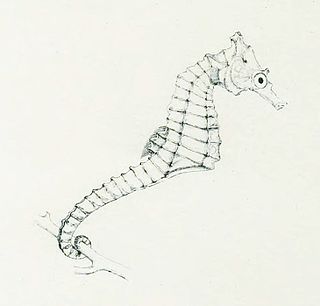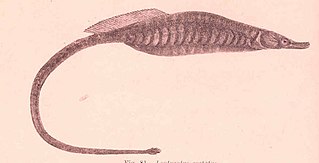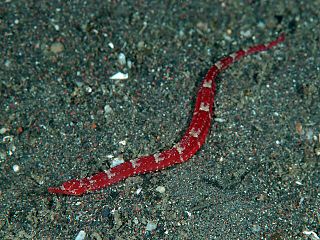
The banded pipefish or ringed pipefish is a species of fish in the Syngnathidae family.

The giraffe seahorse is a species of fish of the family Syngnathidae. It is found in coastal waters off of the south and east coasts of Africa, from South Africa to Tanzania, and possibly north to Kenya. It lives in estuarine seagrass beds, algae beds, and shallow reefs to depths of 45 metres (148 ft), where it can grow to lengths of 10 centimetres (3.9 in). It is expected to feed on small crustaceans, similar to other seahorses. This species is ovoviviparous, with males carrying eggs in a brood pouch before giving birth to live young. Individuals are sexually mature at around 6.5 centimetres (2.6 in). Major threats to this species could be habitat loss, through coastal development and pollution, and overexploitation through bycatch.

The deepbody pipefish is a species of pipefish endemic to Australia where it is only found along the southern coast. This species grows to a length of 12.9 centimetres (5.1 in) SL. This species is the only known member of the monotypic genus Kaupus which is named in honour of the ichthyologist Johann Jakob Kaup (1803-1873).
Corythoichthys amplexus, known commonly as the many-spotted pipefish or yellow-spotted pipefish , is a species of marine fish in the family Syngnathidae.

The redstripe pipefish is a fish from the genus Dunckerocampus. One place it can be found is by the Hawaiian islands.
Bhanotia fasciolata is a marine fish of the family Syngnathidae. It is found in coral reefs, tidepools, and muddy/silty substrates in the Eastern Indian Ocean and Western Pacific. It inhabits at a depth range of 3–25 metres (9.8–82.0 ft), where it can grow up to 9 centimetres (3.5 in). It is ovoviviparous, with the male carrying the eggs in a brood pouch until they are ready to hatch.
Bhanotia nuda is a marine fish of the family Syngnathidae. It is found in the western central Pacific, near Palau and southeastern Papua New Guinea. It inhabits shallow reef habitats, mangrove forests, coral reefs, and silty waters, where it can grow to lengths of 7 centimetres (2.8 in). This species is ovoviviparous, with the males carrying eggs in brood pouches until they are ready to hatch.
Bryx analicarens is a species of marine fish of the family Syngnathidae. It is found in rocky tidepools and algae to depths of 45 metres (148 ft), in the Indian Ocean, Red Sea, and Persian Gulf. It can grow to lengths of 13 centimetres (5.1 in), and is suspected to feed on benthic and planktonic crustaceans. This species is ovoviviparous, with the males carrying eggs in a brood pouch until they hatch.
Campichthys tricarinatus is a species of marine fish of the family Syngnathidae. It is found in the western central Pacific Ocean, from Montebello Island to Cape York (Queensland), and specimens have been recorded around the Northern Mariana and Marshall Islands. It is found at depths of 3–11 metres (9.8–36.1 ft), and can grow to lengths of 4.4 centimetres (1.7 in). This species is ovoviviparous, with males carrying eggs in a brood pouch until giving birth to live young.

Choeroichthys brachysoma is a species of marine fish of the family Syngnathidae. It is found in the Indo-Pacific, from the Red Sea and East Africa to the Society Islands, the Philippines, Guam, and northern Australia. It inhabits tide pools, seagrass, rocky coastlines, mangroves, and coral reef areas at depths of 2–25 metres (6.6–82.0 ft), where it can grow to lengths of 7 centimetres (2.8 in). C. brachysoma shows sexual dimorphism, the females are slender with two rows of black spots along their flanks, while the males have a shorter, wider body marked with scattered, small white spots. This species is ovoviviparous, with males carrying eggs in a brood pouch until giving birth to live young. Males may brood at 3.5–4 centimetres (1.4–1.6 in).
Choeroichthys cinctus is a species of marine fish of the family Syngnathidae. It is found in the Western Pacific Ocean, from Indonesia and the Philippines to Samoa, where it usually inhabits sheltered reef habitats at depths over 10 metres (33 ft). It can grow to lengths of 10 centimetres (3.9 in). This species is ovoviviparous, with males carrying eggs in a brood pouch until giving birth to live young. Males may brood at 3 centimetres (1.2 in).

Doryrhamphus negrosensis, commonly known as Negros pipefish, flagtail pipefish, Masthead Island pipefish or Queensland flagtail pipefish, is a species of marine fish of the family Syngnathidae. It is found in the Western Pacific Ocean, from Borneo to Vanuatu and the Yaeyama Islands to the Rowley Shoals and the Great Barrier Reef. It lives in mud flats and reefs, both coral and rocky, where it is often associated with sea urchins. It is a rather solitary species which may be found in pairs or small groups. It inhabits depths to 9 metres (30 ft), and can grow to lengths of 6.2 centimetres (2.4 in). Although little is known of its feeding habits, it is expected to feed on harpacticoid copepods, gammarid shrimps, and mysids, similar to other pipefish, it may also act as a cleaner fish like other species in the genus Doryrhamphus. This species is ovoviviparous, with males carrying eggs before giving birth to live young. Males may brood at 4.3 cm. It is a small bluish to bluish-grey pipefish which has a pale stripe along the dorsal side of the head and snout, and a dark fan-like caudal fin which has white margins and an orange base.

Dunckerocampus boylei is a species of marine fish of the family Syngnathidae. It is found in the Red Sea, Mauritius, and Indonesia, but it is thought to be widespread throughout the Indian Ocean. It lives in coastal caves and crevices at depths of 20–40 metres (66–131 ft), where it can grow to lengths of 16 centimetres (6.3 in). It feeds on small crustaceans that grow on other fish species. This species is ovoviviparous, with males carrying eggs and giving birth to live young. The specific name honours Bill Boyle, an underwater fish photographer who drew the attention of Kuiter to the species.

Dunckerocampus multiannulatus is a species of marine fish of the family Syngnathidae. It is widespread in the Indian Ocean, from the Red Sea and South Africa to the Andaman Islands and Sumatra, Indonesia. It inhabits coral and rocky reefs to depths of 45 metres (148 ft), where it can grow to lengths of 18 centimetres (7.1 in). It is an active cleaner, feeding on small crustaceans that grow on other fishes. This species is ovoviviparous, with males carrying eggs and giving birth to live young. Males may brood at 13 centimetres (5.1 in).
Dunckerocampus naia is thought to be a species of marine fish of the family Syngnathidae, although further taxonomic study is needed to determine if the classification is valid or if this species is synonymous with D. dactyliophorus. It is found in the Pacific Ocean, off of Japan, Guam, Indonesia, Fiji, and the Solomon Islands. It lives in caverns or under ledges amongst rocky or coral reefs at depths of 15–40 metres (49–131 ft), where it can grow to lengths of 12 centimetres (4.7 in). It is expected to feed on small crustaceans. This species is ovoviviparous, with males carrying eggs and giving birth to live young.

Dunckerocampus pessuliferus is a species of marine fish of the family Syngnathidae. It is a coastal species, inhabiting waters around the Coral Triangle, including the Philippines, Indonesia, and northwestern Australia. It lives in coral patches on sandy and muddy slopes at depths of 15–44 metres (49–144 ft), where it can grow to lengths of 16 centimetres (6.3 in). It is an active cleaner, feeding off of parasitic crustaceans growing on other fishes. The adult fish form pairs and are normally observed swimming along the bottom around large remote coral heads on muddy slopes. This species is ovoviviparous, with males carrying eggs and giving birth to live young.

The red pipefish is a species of marine pipefish of the family Syngnathidae. It is found throughout the Indo-Pacific, from Mozambique and South Africa to Hawaii, Honshu (Japan), and New Caledonia. It lives among rubble and coral or rocky reefs at depths of 18–40 metres (59–131 ft), where they can grow to lengths of 10 centimetres (3.9 in). They are expected to feed on small crustaceans, such as gammarid shrimps, mysids, and harpacticoid copepods. This species is ovoviviparous, with males brooding eggs and giving birth to live young. Males may brood at lengths of around 5.5 centimetres (2.2 in). It is exported from Hawaii as part of the aquarium trade.
Festucalex kulbickii, commonly known as Kulbicki’s pipefish, or New Caledonian pipefish, is a species of marine fish of the family Syngnathidae. It is found from West Papua, Indonesia and Papua New Guinea to New Caledonia. It lives in coral reefs to depths of 56 metres (184 ft), where it can grow to lengths of 6.8 centimetres (2.7 in). It is expected to feed on small crustaceans, similar to other pipefish. This species is ovoviviparous, with males brooding eggs and giving birth to live young. The specific name honours Dr. Michel Kulbicki of L’Institut de recherche pour le développement (IRD) in Nouméa, New Caledonia.
Hippocampus casscsio, the Beibu Bay seahorse, is a species of marine fish of the family Syngnathidae. It is found off the coast of Hainan, China, and from sites around Beibu Bay/the Gulf of Tonkin. It inhabits shallow coastal waters to depths of 15 metres (49 ft). It is expected to consume small benthic and planktonic crustaceans such as copepods, shrimps, and mysids, similar to other seahorses. This species is ovoviviparous, with males brooding eggs in a brood pouch before giving birth to live young. It grows to a length of 13.3 centimetres (5.2 in).

The Samoan pipefish, or brown pipefish, is a species of marine fish of the family Syngnathidae. It is found in the Indo-Pacific, from the Red Sea, to Sodwana Bay, to Taiwan, the Marshall Islands, and Samoa, where it inhabits tidepools and coral and rocky reefs to depths of 15 metres (49 ft). It is a solitary species with cryptic habits and is rarely observed. It is likely to feed on small crustaceans, and can grow to lengths of 14 centimetres (5.5 in). This species is ovoviviparous, with males carrying the fertilised eggs in a brood pouch, the folds of which fall well short of the centre of the egg-filled pouch, eventually giving birth to live young. The specific name honours Mataafa, a former king of Samoa. It is a listed marine species under the Australian Environment Protection and Biodiversity Conservation Act 1999.












